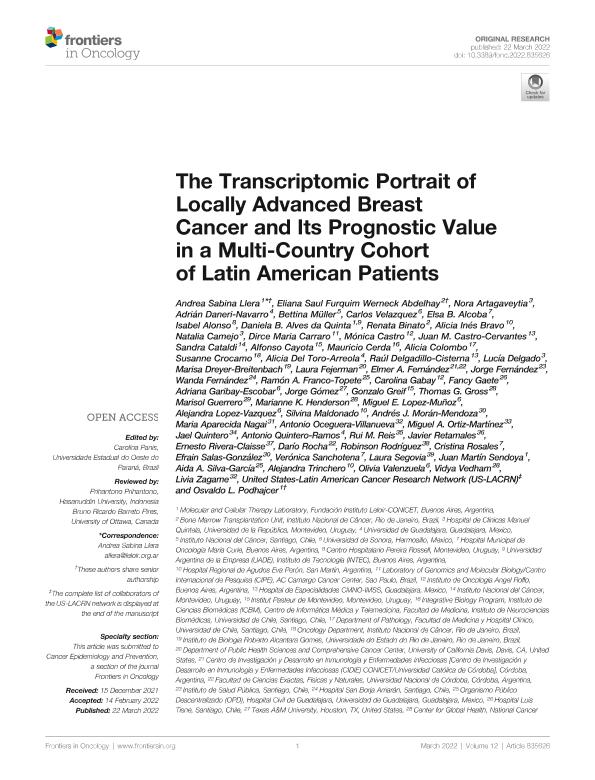Artículo
The Transcriptomic Portrait of Locally Advanced Breast Cancer and Its Prognostic Value in a Multi-Country Cohort of Latin American Patients
Llera, Andrea Sabina ; Abdelhay, Eliana Saul Furquim Werneck; Artagaveytia, Nora; Daneri Navarro, Adrián; Müller, Bettina; Velazquez, Carlos; Alcoba, Elsa B.; Alonso, Isabel; Alves Da Quinta, Daniela Belén
; Abdelhay, Eliana Saul Furquim Werneck; Artagaveytia, Nora; Daneri Navarro, Adrián; Müller, Bettina; Velazquez, Carlos; Alcoba, Elsa B.; Alonso, Isabel; Alves Da Quinta, Daniela Belén ; Binato, Renata; Bravo, Alicia Inés; Camejo, Natalia; Carraro, Dirce Maria; Castro, Mónica; Castro Cervantes, Juan M.; Cataldi, Sandra; Cayota, Alfonso; Cerda, Mauricio; Colombo, Alicia; Crocamo, Susanne; Del Toro Arreola, Alicia; Delgadillo Cisterna, Raúl; Delgado, Lucía; Fernandez, Elmer Andres
; Binato, Renata; Bravo, Alicia Inés; Camejo, Natalia; Carraro, Dirce Maria; Castro, Mónica; Castro Cervantes, Juan M.; Cataldi, Sandra; Cayota, Alfonso; Cerda, Mauricio; Colombo, Alicia; Crocamo, Susanne; Del Toro Arreola, Alicia; Delgadillo Cisterna, Raúl; Delgado, Lucía; Fernandez, Elmer Andres ; Fejerman, Laura
; Fejerman, Laura ; Trinchero, Alejandra; Valenzuela, Olivia; Vedham, Vidya; Zagame, Livia; Podhajcer, Osvaldo Luis
; Trinchero, Alejandra; Valenzuela, Olivia; Vedham, Vidya; Zagame, Livia; Podhajcer, Osvaldo Luis
 ; Abdelhay, Eliana Saul Furquim Werneck; Artagaveytia, Nora; Daneri Navarro, Adrián; Müller, Bettina; Velazquez, Carlos; Alcoba, Elsa B.; Alonso, Isabel; Alves Da Quinta, Daniela Belén
; Abdelhay, Eliana Saul Furquim Werneck; Artagaveytia, Nora; Daneri Navarro, Adrián; Müller, Bettina; Velazquez, Carlos; Alcoba, Elsa B.; Alonso, Isabel; Alves Da Quinta, Daniela Belén ; Binato, Renata; Bravo, Alicia Inés; Camejo, Natalia; Carraro, Dirce Maria; Castro, Mónica; Castro Cervantes, Juan M.; Cataldi, Sandra; Cayota, Alfonso; Cerda, Mauricio; Colombo, Alicia; Crocamo, Susanne; Del Toro Arreola, Alicia; Delgadillo Cisterna, Raúl; Delgado, Lucía; Fernandez, Elmer Andres
; Binato, Renata; Bravo, Alicia Inés; Camejo, Natalia; Carraro, Dirce Maria; Castro, Mónica; Castro Cervantes, Juan M.; Cataldi, Sandra; Cayota, Alfonso; Cerda, Mauricio; Colombo, Alicia; Crocamo, Susanne; Del Toro Arreola, Alicia; Delgadillo Cisterna, Raúl; Delgado, Lucía; Fernandez, Elmer Andres ; Fejerman, Laura
; Fejerman, Laura ; Trinchero, Alejandra; Valenzuela, Olivia; Vedham, Vidya; Zagame, Livia; Podhajcer, Osvaldo Luis
; Trinchero, Alejandra; Valenzuela, Olivia; Vedham, Vidya; Zagame, Livia; Podhajcer, Osvaldo Luis
Fecha de publicación:
03/2022
Editorial:
Frontiers Media
Revista:
Frontiers in Oncology
ISSN:
2234-943X
Idioma:
Inglés
Tipo de recurso:
Artículo publicado
Clasificación temática:
Resumen
Purposes: Most molecular-based published studies on breast cancer do not adequately represent the unique and diverse genetic admixture of the Latin American population. Searching for similarities and differences in molecular pathways associated with these tumors and evaluating its impact on prognosis may help to select better therapeutic approaches. Patients and Methods: We collected clinical, pathological, and transcriptomic data of a multi-country Latin American cohort of 1,071 stage II-III breast cancer patients of the Molecular Profile of Breast Cancer Study (MPBCS) cohort. The 5-year prognostic ability of intrinsic (transcriptomic-based) PAM50 and immunohistochemical classifications, both at the cancer-specific (OSC) and disease-free survival (DFS) stages, was compared. Pathway analyses (GSEA, GSVA and MetaCore) were performed to explore differences among intrinsic subtypes. Results: PAM50 classification of the MPBCS cohort defined 42·6% of tumors as LumA, 21·3% as LumB, 13·3% as HER2E and 16·6% as Basal. Both OSC and DFS for LumA tumors were significantly better than for other subtypes, while Basal tumors had the worst prognosis. While the prognostic power of traditional subtypes calculated with hormone receptors (HR), HER2 and Ki67 determinations showed an acceptable performance, PAM50-derived risk of recurrence best discriminated low, intermediate and high-risk groups. Transcriptomic pathway analysis showed high proliferation (i.e. cell cycle control and DNA damage repair) associated with LumB, HER2E and Basal tumors, and a strong dependency on the estrogen pathway for LumA. Terms related to both innate and adaptive immune responses were seen predominantly upregulated in Basal tumors, and, to a lesser extent, in HER2E, with respect to LumA and B tumors. Conclusions: This is the first study that assesses molecular features at the transcriptomic level in a multicountry Latin American breast cancer patient cohort. Hormone-related and proliferation pathways that predominate in PAM50 and other breast cancer molecular classifications are also the main tumor-driving mechanisms in this cohort and have prognostic power. The immune-related features seen in the most aggressive subtypes may pave the way for therapeutic approaches not yet disseminated in Latin America. Clinical Trial Registration: ClinicalTrials.gov (Identifier: NCT02326857).
Archivos asociados
Licencia
Identificadores
Colecciones
Articulos(CIDIE)
Articulos de CENTRO DE INV. Y DESARROLLO EN INMUNOLOGIA Y ENFERMEDADES INFECCIOSAS
Articulos de CENTRO DE INV. Y DESARROLLO EN INMUNOLOGIA Y ENFERMEDADES INFECCIOSAS
Articulos(IIBBA)
Articulos de INST.DE INVEST.BIOQUIMICAS DE BS.AS(I)
Articulos de INST.DE INVEST.BIOQUIMICAS DE BS.AS(I)
Citación
Llera, Andrea Sabina; Abdelhay, Eliana Saul Furquim Werneck; Artagaveytia, Nora; Daneri Navarro, Adrián; Müller, Bettina; et al.; The Transcriptomic Portrait of Locally Advanced Breast Cancer and Its Prognostic Value in a Multi-Country Cohort of Latin American Patients; Frontiers Media; Frontiers in Oncology; 12; 835626; 3-2022; 1-21
Compartir
Altmétricas



